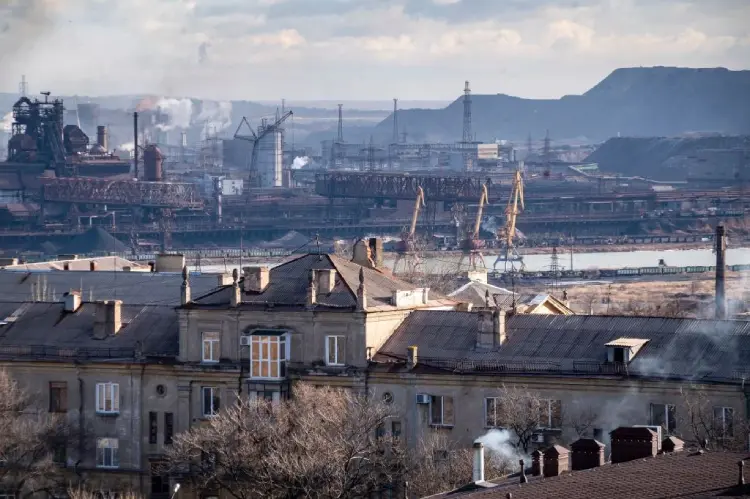
The impact of Russia’s war with Ukraine for the semiconductor industry was brought into focus on Thursday when South Korea’s government removed import tariffs on three gasses which are vital to chip production to protect supply. It is the latest move taken by businesses and governments to head off issues caused by the conflict. Despite bullish talk from industry insiders that they are well-placed to cope with any disruption, the long-term impact of the war on the sector remains uncertain.

South Korea is a hub for semiconductor production and home to the world’s second-largest contract chip manufacturer, Samsung, as well as major suppliers of memory chips such as SK Hynix. From next month, it will remove the current 5.5% import charge applied to neon, xenon and krypton, three gases used in the production of advanced chips. South Korea relies on imports of these gases from Russia and Ukraine, but the conflict and accompanying sanctions on Russia have cut off its supply.
“If the situation gets protracted, we are very concerned that its impact on the economy will likely expand, given that the effect of the Ukraine crisis on the real economy has begun to be felt,” South Korea’s finance minister Hong Nam-ki said, as reported by the Korea Times.
Chipmakers elsewhere have made their contingency plans to withstand supply shortages and the geopolitical fall-out from a conflict that has seen the industry used as a tool to sanction Russia for its actions.
Will anyone sell chips to Russia?
The global sanctions imposed on Russia when war broke out led the semiconductor industry’s biggest names to cease exports to Moscow. Intel, AMD and TSMC were among the companies that swiftly confirmed they would no longer be supplying Russian clients, and on Wednesday Qualcomm said it was no longer working with businesses in Russia following a Twitter exchange with Ukraine’s vice prime minister Mykhailo Fedorov.
This is incorrect. Qualcomm has called for a peaceful resolution to Russia’s aggression in Ukraine, made direct donations to relief organizations, & match employee contributions. We have stopped selling products to Russian companies & comply with US sanctions.
— Qualcomm (@Qualcomm) March 16, 2022
When it comes to buying chips, Russia is a small market, representing just 0.1% of an industry worth $550bn. Its biggest buyer of semiconductors is its armed forces says Dan Hutcheson, vice chair of industry analyst firm TechInsights. “On the military side of it, missiles, drones and other smart weapons all require pretty advanced chips,” he says, “though the Russian military has always been about five nodes behind in terms of technology use.”
This reliance on older process nodes could see Russia turn to Chinese chip manufacturers, which have been shut out of the market for leading-edge chips by the ongoing trade war with the US, but which have the capability to produce semiconductors on older processes.
Earlier this month US commerce secretary Gina Raimondo warned Chinese companies such as SMIC, China’s biggest chipmaker, that they could face sanctions of their own if they are seen to be helping Russia. “We could essentially shut SMIC down because we prevent them from using our equipment and our software,” Raimondo said in an interview with the New York Times, referencing the kind of sanctions which have been applied to Huawei and severely restricted its ability to operate outside of China.
SMIC is already on the US ‘entity list’, meaning it is restricted from accessing leading-edge chip technology nodes. The company itself hasn’t commented publicly on its stance on Russia, but on Thursday two US lawmakers, Marco Rubio and Michael McCaul wrote to President Joe Biden requesting further sanctions be imposed on the company in case it decides to come to Russia’s aid. “Adopting a stronger export control approach vis-à-vis SMIC would fortify American industry, weaken a malign CCP competitor, and further cut off the flow of critical technology to Russia as it upends the rules-based international order and invades a neighbouring democracy,” the duo wrote.
Hutcheson says this sabre-rattling from across the Atlantic is unlikely to impact SMIC’s position on Russia as much as the stance of the Chinese regime. “I doubt SMIC are afraid of the US government, but they are going to be afraid of the Chinese government, because that has a lot more impact on them,” he says. “So if the Chinese government comes through and supports Putin, the question is not [whether SMIC would supply Russia] but if anyone finds out about it.”
Indeed, he believes it may not be possible for the US and its allies to find out if SMIC is boosting the Russian chip supply. “If chips get packaged and put into things like missiles it’s really difficult to track where they’re going,” he says. “The two countries share a border, so it’s not like anyone else is really going to know what happens there.”
Will the chip industry run out of neon?
For other chipmakers, the supply of neon gas – used during the lithography phase of the chip manufacturing process – has been the main concern. Neon is a by-product of the steel industry, and Russia and Ukraine are both big producers globally. The conflict has resulted in Ukraine’s two biggest neon producers, Ingas and Cryoin, halting production completely.
That’s a “big concern” for the chip industry, says Lita Shon-Roy, president and CEO of analyst business Techcet Group. “We estimate 667 million litres of neon were used last year, and another 715 million will be used this year,” she says. “Of that, 40%-50% is coming from the Ukraine and another 40%-50% coming from China. [T]he question is how much do the chip fabricators have in stock and how long can they last?”
Many in the industry have been keen to downplay concerns, with both Intel and TSMC saying they have sufficient stocks of neon to avoid supply problems. US trade body the Semiconductor Industry Association (SIA) said it is confident its members will not be badly affected, especially as many put contingency plans in place after Russia invaded Crimea in 2014, which led to similar issues. “The semiconductor industry has a diverse set of suppliers of key materials and gases, so we do not believe there are immediate supply disruption risks related to Russia and Ukraine,” SIA president John Neuffer said.
TechInsights’ Hutcheson believes the larger chip producers have up to six months’ worth of neon in stock, while Mike Orme, who covers the semiconductor market for GlobalData, says he believes “the threat to the global chip industry of the neon gas situation may be over-egged and marginal rather than highly serious in impact”.
“The industry has taken major precautionary moves to stockpile substantially, as it did in 2014, ahead of the invasion,” Orme adds. “And other gases such as chlorine and fluorine are credible alternatives to neon. Nonetheless, it will be a factor in protracting the global chip shortage.”
Are there long-term implications of the Russia-Ukraine war for the chip industry?
Shon-Roy is less confident the problems will be short-lived. “The big names like Intel, TSMC and Samsung are all fighting for the same supply,” she says. “They have big buying power and are going to be prioritised [by neon suppliers] because you don’t want to short your biggest customers. And they have technical manufacturing plants with a lot of smart engineers, so I would bet they are looking for ways to become more efficient at their neon usage.”
Smaller chip makers might only hold four-to-six weeks’ worth of neon supply, so problems might mount more quickly, Shon-Roy says. “The bigger the company the cushier your buffer is likely to be,” she says. “The problem is, no one has the buffer they would like because the supply chain has been so-oversubscribed.”
Because of this, bigger chip supply problems may be round the corner. “Anyone who doesn’t think this is going to slow down the chip industry is dreaming,” Shon-Roy says. “People might not be saying it now because if you’re a chipmaker that’s a public company you don’t want to admit this until the last possible minute, and they’re all trying to remedy the situation as fast as possible. We don’t know yet whether the impact will be minimal or major, but it’s going to have an impact.”






